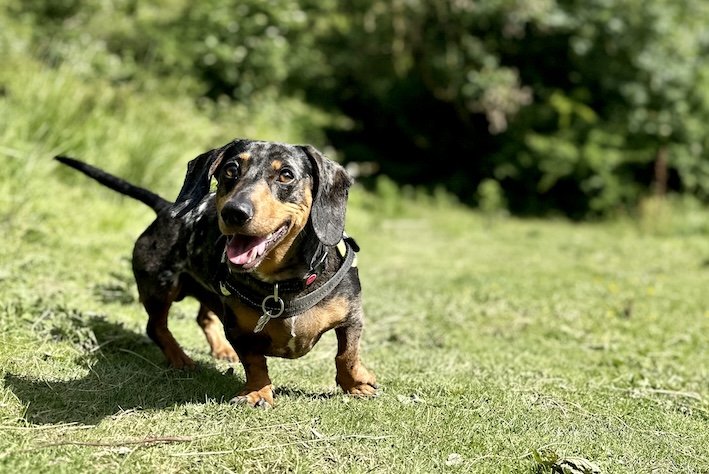Are Dachshunds Good With Children?
Dachshunds can generally be good with children, but as with any dog breed, individual temperament and behaviour can vary. Bringing a dachshund into the family is a big commitment, however one that can bring with it so much joy too.
Dachshunds often form strong bonds with both adults and children. Known for their playful nature and loyalty, these small dogs can adapt well to family life. Families considering a dachshund as a pet may find that their dachshund’s affectionate and energetic disposition makes them a compatible pet to have with children, adding a lively presence to the household.
However, as always, there are some considerations to think about when introducing a dachshund into a family.
Dachshund Temperament
Dachshunds are often known for their loyalty and affectionate nature, making them possible candidates for becoming devoted family pets, particularly for those with children.
These small dogs often form strong bonds with children, offering a source of companionship and warmth within the family setting. Their inherent affectionate and playful traits contribute to a positive and engaging relationship with children, establishing the dachshund as a fun and loving addition to the family.
Dachshund Size
The size of a dachshund, especially the miniature variety, makes them often well-suited for families with children. However, despite their small stature, it’s imperative to educate children on the importance of handling these dogs gently and respectfully.
The smaller size of dachshunds can make them more approachable for young children, while proper understanding and guidance on how they should interact safely can promote an environment where both the dog and the children can coexist well.
The more manageable size of dachshunds also facilitates indoor living in smaller spaces such as small houses, apartments or flats, making them adaptable companions that seamlessly fit into family life, regardless of living space. This was certainly a consideration for us when we took on our puppy, as living in a smaller house with a tiny outdoor space, wanted to ensure that the dog breed we chose would be have enough space to live comfortably.
Supervising Dachshunds With Children
When integrating a dachshund into a family with young children, constant supervision during interactions is the most important thing to consider. Regardless of the dog’s training or gentle disposition, close monitoring is necessary to prevent inadvertent rough play or misunderstandings between the dachshund and any children.
Ensuring a safe environment through close supervision contributes to a positive relationship, fostering a sense of security for both the dachshund and the children. It is also an opportunity to observe and reinforce positive behaviours, creating a foundation for a respectful and trusting relationship within the family.
Teaching children how to interact with your dog and establishing boundaries for both parties contributes to a safe coexistence. An educational approach helps develop a sense of responsibility in children while ensuring that the dachshund understands its role within the family dynamic, promoting a healthy and balanced relationship. Involving the entire family in the training process can strengthen the bond between the dachshund and each family member, creating a cohesive and well-behaved family unit.
Dachshund Socialisation With Children
Early socialisation is a key aspect of integrating Dachshunds into a family with children. Exposing the dog to various experiences, including positive interactions with children, from a young age helps them become more adaptable and comfortable with family life. This early exposure contributes to a well-rounded and sociable temperament in the dachshund, enhancing their compatibility within a family environment. Additionally, regular socialisation activities, such as visits to parks or playdates with other dogs and children, can further build the dachshund’s social skills and confidence.
Handling
Dachshunds, like many dogs, may not appreciate rough handling. It is crucial to teach children the importance of gentleness, urging them to avoid pulling on the dog’s ears or tail and refraining from disturbing the dog when it’s eating or resting. This understanding develops a respectful interaction between the children and the dachshund, promoting a positive relationship built on trust and consideration.
Incorporating gentle handling into everyday activities, such as grooming or feeding, can also enhance the bond between the dachshund and the children, creating positive associations with human touch.
Dachshund Energy Levels
Dachshunds exhibit moderate energy levels, enjoying playtime with children while also valuing moments of quiet relaxation. Ensuring the dog receives regular exercise is beneficial for both the dachshund and the family, striking a balance between active play and peaceful coexistence within the household. Tailoring play activities to the dachshund’s energy levels, such as interactive games or short walks, can create a fulfilling and enjoyable experience for both the dog and the children, promoting a healthy and active lifestyle.
Age of Children
The age of your children is also something to consider when deciding whether to take on a dachshund as a family pet. These dogs may sometimes be better suited for families with older children who possess a more mature understanding of how to interact with dogs responsibly. Older children are more likely to follow guidelines on gentle handling and respectful boundaries, contributing to a positive and safe environment for both the dachshund and the family. Involving older children in the dog’s care routines, such as feeding or grooming, can also help to create a sense of responsibility and teamwork within the family.
Territorial Behaviour
Some dachshunds may exhibit territorial behaviour, which underscores the importance of introducing them to new people, including children, in a positive and controlled manner. Taking proactive measures to acclimatise your dachshund to various social situations can help reduce any territorial tendencies, ensuring a smoother integration into a family dynamic. Providing the dachshund with a designated space or safe retreat within the home can also help alleviate territorial stress, creating a secure environment for both the dog and the family members.
Communication
Teaching children how to recognise a dog’s body language and signs of discomfort is also fundamental to preventing misunderstandings and promoting a safer interaction. This knowledge empowers children to interpret your dachshund’s cues, developing a relationship built on mutual understanding and respect. Effective communication between children and the dachshund contributes to a positive and secure environment within the family setting. Furthermore, encouraging open communication within the family about the dog’s needs and preferences facilitates a collaborative and attentive approach to caring for the dachshund.
Before bringing a dachshund into a home with children, it’s essential to assess the individual dog’s temperament and history. Additionally, early and ongoing training and socialisation contribute to a positive relationship between Dachshunds and children. If there are concerns or challenges, consulting with a professional dog trainer or behaviourist can be beneficial.








